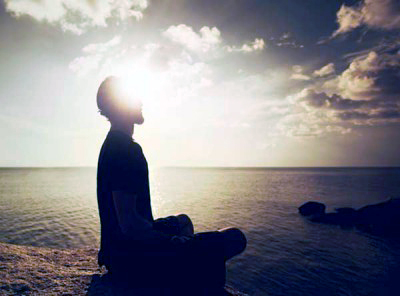Living Meditation

Humans are fundamentally good, caring and wise. We may appear otherwise, but at the core, we are basically good, sound and fully deserving of goodness. So why do we experience such pain in our lives? If we were to find our way to the truth of our existence, we’d see that so much of our struggle is created by a false sense of identification born of reactions to fear and trauma. This self-identification is a protective cocoon woven by habitual patterns of thought and action into a supposed entity. We never really look at it, but nonetheless operate under the assumption that there is someone there, and that this someone is terribly flawed.
In compensation of this presupposed lack, our cocoon works to make itself better, larger, more solid and more complete. Driven by panic, this personal hamster wheel separates us from our true nature and full potential. Ironically, while trying to make us grander, it is grossly limiting our capacity. And, it is employing a lot of work and recourses to do so.
Failing to recognize the possibilities inherent in basic goodness, we make the mistake of personalizing our reactions to pain. In trying to protect us, our cocoon creates a barrier that separates us from direct experience of life. In so doing, it separates us from pain, yes. But, it also separates us from love, joy and other emotions. Our emotions are how we actually feel. So, in this way, we are cut off from intuitive knowledge, understanding and an energetic sense of aliveness. When we create, maintain and defend an identity forged on reactions to pain, we obscure an essential part of ourselves that would actually have a much easier time of things.
One problem is our over-active brains seem to dominate our experience with self-reference. We think too much about everything, cutting ourselves off from our basic animal, intuitive and emotional being. While the brain is plotting, scheming and planning our lives, the body is actually experiencing life. When our identity is centered on the mind, looking through the diminishing lens of self-reference, we wrap the fabric of time and space around us, and create a vortex of need, clinging to everything. Life, on the other hand, understandably tries to distance itself from our grasping. So, the harder we push, the less our needs are met. But, when we stop the cycle of self abuse, and drop into our felt sense of actual experience, we can open to life simply and completely as it is.
The work is to come back – like coming home – to the present, open, aligned body and to accept how we feel, whether frightened, excited, scared or alive.
Connecting to the body brings us back to the earth, the present moment and the seat of authority in our lives. And while the body holds our trauma, it is also the source of well-being and joy.
However, we don’t have to diminish the brain in favor of the body. Likewise, we don’t have to shut out the body in order to allow the brain to work unimpeded. The idea is to find the balance so each can support the other. In this way, we join body, emotions and cognition in synchronicity with life.
A fully integrated meditation practice allows our natural confidence to dawn and develop. Then we can navigate our life toward its purpose with dignity and self-respect. Therefore, life is meditation and meditation is life. And both are aligned to support health, vitality and – dare we say it? – success.
By Joseph Mauricio
Joseph Mauricio, a senior teacher in the Shambhala Buddhist Tradition, is a student of Meditation Master Sakyong Mipham, Rinpoche. He is a writer, performer, lecturer, and founder of LIFEWORK Personal Coaching Services, a meditation, performance, public speaking and personal actualization life coaching service.
